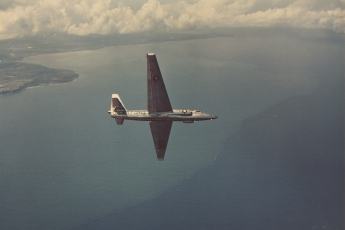
HASP U-2 aircraft out over the Caribbean - US Air Force photo via the National Archives
 HASP U-2 aircraft out over the Caribbean - US Air Force photo via the National Archives |
Slightly more than a year after the CIA received their U-2, the US Air Force received some of its own U-2 aircraft, which became operational in October 1957, assigned to the HASP program.
The High-Altitude Sampling Program or HASP (1957-1963) was the introduction of U-2 aircraft into an existing Air Force reconnaissance research mission to collect air samples in strategic areas of the world, in an effort to detect, and monitor the scientific advancements being made in Soviet nuclear weapons development and testing.
The U-2 was incorporated into this mission with several aircraft specially modified and equipped to collect atmospheric air samples to detecting radioactive debris at high-altitude. Known as "operation crowflight", five Air Force U-2A were modified with nose radomes, encompassing a hole or air intake (valved) mechanism to permit the capture of air gasses for sampling.
Unofficially known as WU-2A, and operating under the guise of weather sampling aircraft, these particular U-2 were additionally equipped with air scoops, mounted on the port and starboard sides of the fuselage to collect radioactive particulate debris in the upper atmosphere.
One of the US Air Force's early strategic reconnaissance squadrons, the 4028th of the 4080th Strategic Reconnaissance Wing, was involved in flying the U-2 HASP flights. Detachments from 4028th deployed all over the world, flying HASP flights from bases in the United States, Europe, Alaska, Australia and Puerto Rico.
HASP sampling flights actually originated with CIA U-2, beginning in 1956, in support of the (then) Armed Forces Special Weapon Project or AFSWP - (later) Defense Nuclear Agency.
These ultra-secret flights, even within the CIA, not only supported monitoring of Soviet nuclear weapons programs, but also supported the establishment of AFSWP worldwide nuclear fallout pattern charts that were developed in association with future nuclear weapons policies and planning.
CIA U-2s carried out covert HASP mission throughout the 1960's, inclusive of the one-known Project Seeker mission, to collect nuclear intelligence data during the French nuclear weapons tests carried out on Mururoa Atoll, French Polynesia, in May 1964.
The Air Force's U-2 HASP flights came to an end in March 1963 with the signing of the Above Ground Test Ban Treaty between the US and the USSR.
In the subsequent U-2 aircraft investigation, in the wake of the Powers shoot-down, US Congressional scrutiny revealed that over 200 U-2 Flights were conducted between 1956-1960 under the auspice of the NACA / NASA weather research (cover) missions.
Although a portion of these 200 flights (24 over-flights of the USSR) were covert CIA flights, the remaining majority of the flights were mostly atmospheric and meteorological research flights flown by the CIA and Air Force for various US Government organizations.
Some of these U-2 research flights included milestone high-altitude missions over the tops of typhoons and hurricane in support of the Air Force's Air Weather Service (AWS) and the US Weather Bureau.